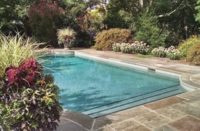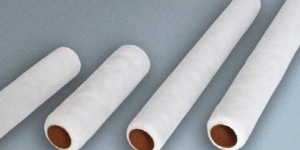
Decorative concrete often appeals to designers and building owners who want to minimize their impact on the environment and want to go green in decorative concrete. Because polished, stamped or textured surfaces eliminate the need for coverings that perpetually need replacement.
Acquainting yourself with what constitutes a green product and developing an arsenal of them can help you communicate with environmentally minded customers and, consequently, court their business.
What’s a green product?
LEED, or Leadership in Energy and Environmental Design, developed by the U.S. Green Building Council, is the U.S.’s best-known standard. Buildings accumulate LEED points based on how their design, construction, maintenance and operation avoid carbon emissions, pollution and energy consumption.

Products don’t get LEED ratings, but using certain products earns LEED points for a building by meeting sustainability goals. Manufacturers pay a fee to submit their products for certification as sustainable. To learn more about certifying organizations, visit www.inhabitat.com and search for “green building labels 101.”
Prosoco, which makes cleaners, sealers and consolidators for concrete and masonry, has several third-party certifications, says Kevin Sigourney, product manager for Prosoco’s floor-finishing Consolideck line.
“We were among the first coating producers to have emissions testing and third-party certifications done on our concrete floor offerings,” he says. “We’ve finished or refinished over 700 million square feet of concrete with products certified as Indoor Advantage Gold and conformant with all green building standards.”
The Indoor Advantage Gold standard, administered by SCS Global Services, identifies products that meet LEED v4 EQ credit criteria. When a product is certified, it will contribute to LEED points, Sigourney says.
A noncertified product can still be sustainable. Ned Matteson of Endurable Concrete Products says products that are biodegradable or nontoxic are becoming the norm.
“Our company has gone away from anything that isn’t considered a green-type product,” he says. “Chemistry has changed, and it isn’t necessary to be using toxic solvents anymore to make high-performance products.”

Most of Endurable’s products are qualified to earn LEED points. Its Endurable Concrete Sealer has a two-part water-based polyurethane chemistry that Matteson says far outlasts solvent-based acrylic sealers.
Good for the environment
For every chemical-laden product you use, there’s probably a version that’s friendlier to the environment.
Franmar, for instance, has environmentally friendly form releases compatible with wood, steel, urethane and silicone, and latex that won’t harm the planet like petroleum-based products. The company’s Blue Bear cleaning products are also easy on the environment. They are all made from soybeans and natural elements. And they have another benefit, says marketing coordinator Scott Sarver.
“There’s a lot of nasty chemicals where you have to deal with a lot of personal protective equipment,” he says, and worry about what the exposure is doing to you and your workers. “You don’t have to worry about that with our products.” What’s good for the environment is generally good for your employees, too. “One of our favorite products has been soy gel-based for the removal of sealers,” says John Fletcher of Carolina Bomanite. “We are big proponents of the use of water-based sealers around pools and bodies of water where runoff or contamination may be a concern. It’s also easier for our employees to use.
NewLook, too, has several products with sustainability value. Its Slik Zero, with zero VOCs, is an example of a biodegradable form release which reacts with the lime in the concrete to form a layer of water-insoluble soaps between the form and the concrete.
NewLook also makes Eco Acid, a noncorrosive, nonfuming alternative to acid cleaners used to prepare concrete for staining. Another NewLook product, Faux Fusion, is a nonacid-based stain engineered to be colorfast outdoors, says NewLook’s marketing director, Beau Young. Nonacid stains, he notes, don’t need to be neutralized, eliminating the neutralizer disposal problem.
NewLook’s Endura Cool Stain contains reflective pigments that reduce the temperature of concrete surfaces by reflecting sunlight. Reducing the amount of sunlight that concrete absorbs helps reduce the “urban heat island” effect of concrete surfaces, a desirable sustainability goal.
Another way to reduce the temperature of concrete is to texture it in such a way that bumps on the surface shade it from the sun. Mortex pioneered this in 1962 with its Kool Deck topping, a fully cementitious decking material, and other textured toppings claiming the same benefit.
Seeming green versus being green
Sigourney of Prosoco says the green market abounds in misinformation. “A lot of companies have been greenwashing, taking liberties,” he says, explaining that some companies will say, ‘It’s water-based, so it’s green.’ “Well, it might be water-based, but it contains phosphates. There are a lot of water-based products that wouldn’t necessarily meet a green standard. It might contain a chemical that has a negative impact on the environment. You can’t just rely on a company putting a green leaf on a product.”

Yet another misconception is that a product formulated for sustainability value won’t work as well as an old-school product. Franmar’s Sarver will put his company’s soy-based coating removers up against any formulation. Its 600 GL paint and urethane stripper has been around for 30 years. “Soy is a fantastic migrator through all these coatings,” he says. “It has no bioaccumulability, so there is no environmental hazard.”
To sell green, be green, go green in decorative concrete
Customers interested in sustainable construction tend to be associated with institutions, technology corporations or high-end homes. Some decorative concrete contractors specialize in marketing their services to these prospective customers.
Kevin Barnett, a principal of Clean Cut Concrete in San Jose, California, is one of them. “I’ve been a builder all my life, and when I got my first professional construction management job in 2006 I was blown away by how much waste was going off of every construction site,” he recalls. On one memorable occasion, he had just finished a commercial remodel when the tenant decided its company had outgrown the space. The tenant subleased the space to new tenants, who subsequently demolished the brand-new interior because it wasn’t to their liking.
“There were dumpsters full of brand-new carpet being hauled to the dump,” Barnett said. “There had to be a better way.”

Barnett started studying sustainable construction and got his LEED Accredited Professional certification in 2009. After meeting concrete polishing guru Bill Brown out of San Francisco in 2011, he focused on polished concrete flooring because it doesn’t off-gas chemicals the way many petroleum-based floor coverings do, which helps maintain indoor air quality.
“We select the products that are most environmentally friendly and deliver the best performance,” Barnett says. Clean Cut Concrete mechanically finishes floors to a high polish and uses penetrating guards as opposed to topical sealers, which require periodic stripping with harsh chemicals and replacement.
Clean Cut Concrete also practices a no-waste philosophy in its day-to-day business. Barnett says that’s a good idea for any contractor who wants to serve the green market. “I hope when people see our office staff drives hybrids, and our crews bring reusable water bottles to the site every day, and our office is lined with reclaimed wood, they see that we’re doing everything we can to reduce waste,” he says. “I hope they see we actually care, and we’re not just checking a box.”
If you want to market your services to architects and building owners who are interested in sustainable construction, getting a LEED credential is a good start, Barnett says. The USGBC offers a LEED Green Associate certification that attests to general knowledge of sustainable construction, then LEED Accredited Professional certifications in various areas.
How green can it get?
Concrete may already be green, but even greener developments are on the horizon. Several European research groups are working on bioreceptive concrete, designed to foster the growth of plants. From the inside to the outside, it has a waterproofing layer to protect the structural concrete, a porous layer that supports plant growth and retains rainwater, and a discontinuous coating that lets the rainwater in but retards its evaporation.
The porous layer incorporates magnesium phosphate cement, a product used for concrete repairs that’s slightly acidic and more plant-friendly than portland cement. The material can be formed into concrete panels with dimpled textures suitable for seeding with mosses. Instead of spraying concrete with harsh chemicals to get rid of moss, building owners may soon be bragging about the growth on their truly green buildings.
Bomanite’s Fletcher finds sustainability may sometimes be a tough sell. “Our Grasscrete product defines the term and has been around for many years, but municipalities and cities still fail to fully understand the practical use of the product for sustainable construction,” he says.
Still, Fletcher brings green alternatives to his customers’ attention. “For projects that might have more public exposure, we may provide ‘greener’ alternatives to our clients with the understanding that there may be a variant in price.” Fletcher knows how to go green in decorative concrete.
www.carolinabomanite.com
www.cleancutconcrete.com
www.endurableproducts.com
www.franmar.com
www.getnewlook.com
www.mortex.com
www.prosoco.com
www.scsglobalservices.com
www.usgbc.org














